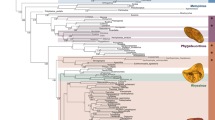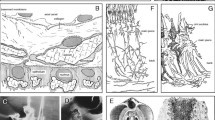Abstract
Fossilization in amber is unique in preserving specimens with microscopic fidelity; however, arthropod inclusions are rarely examined beyond the exoskeleton as this requires destructive sampling when traditional techniques are used. We report the first complete, digital 3D, non-destructive reconstruction of the anatomy of an insect fossil, a specimen of †Mengea tertiaria embedded in a 42-Ma Baltic amber. This was made possible using Synchrotron μ-CT. The species belongs to the stem group of the phylogenetically enigmatic and extremely specialized Strepsiptera. Most internal structures of the fossil are preserved, but small parts of the lumen had decayed due to incomplete infiltration of the resin. Data on internal organs provided additional information for resolving phylogenetic relationships. A sister group relationship between †Mengea and all extant lineages of the group was confirmed with characters previously not accessible. The newly gained information also yielded some insights in the biology of †Mengea and the early evolutionary history of Strepsiptera. The technique has a tremendous potential for a more accurate interpretation of diverse fossil arthropods preserved in ambers from 130 Ma to the present.

Similar content being viewed by others
References
Azar D (1997) A new method for extracting plant and insect fossils from Lebanese amber. Palaeontology 40:1027–1029
Beckmann F (2008) Neutron and synchrotron-radiation based imaging for applications in materials science—from macro- to nanotomography. In: Reimers W, Pyzalla AR, Schreyer A, Clemens H (eds) Neutrons and synchrotron radiation in engineering materials science. Wiley VCH Verlag, Weinheim, pp 287–307
Beckmann F, Donath T, Fischer J, Dose T, Lippmann T, Lottermoser L, Martins RV, Schreyer A (2006) New developments for synchrotron-radiation-based microtomography at DESY. Proc SPIE 6318:631810–631811
Beckmann F, Herzen J, Haibel A, Müller B, Schreyer A (2008) High density resolution in synchrotron-radiation-based attenuation-contrast microtomography. Proc SPIE 7078:70781D
Beutel RG, Pohl H (2006) Head structures of males of Strepsiptera (Hexapoda) with emphasis on basal splitting events within the order. J Morphol 267:536–554
Beutel RG, Pohl H, Hünefeld F (2005) Strepsipteran brains and effects of miniaturization (Insecta). Arthropod Struct Dev 34:301–313
Bravo F, Pohl H, Silva-Neto A, Beutel RG (2009) Bahiaxenidae, a “living fossil” and a new family of Strepsiptera (Hexapoda) discovered in Brazil. Cladistics 25:614–623
Grabert B (1953) Bau der Geschlechtsorgane und Kopulation beim Stylops-Männchen (Strepsiptera, Insecta). Diploma thesis, Zoologisches Institut, Freie Universität Berlin
Grimaldi D (2003) Amber: window to the past. Harry N. Abrams, Inc., New York
Grimaldi D, Engel MS (2005) Evolution of the Insects. Cambridge University Press, New York
Grimaldi D, Bonwich E, Delannoy M, Doberstein S (1994) Electron microscopic studies of mummified tissues in amber fossils. Am Mus Nov 3097:1–31
Grimaldi D, Kathirithamby J, Schawaroch V (2005) Strepsiptera and triungula in cretaceous amber. Insect Syst Evol 36:1–20
Heethoff M, Helfen L, Norton RA (2009) Description of Neoliodes dominicus n.sp. (Acari, Oribatida) from Dominican amber, aided by synchrotron X-ray microtomography. J Paleontol 83:153–159
Hennig W (1965) Die Acalyptratae des baltischen Bernsteins und ihre Bedeutung für die Erforschung der phylogenetischen Entwicklung dieser Dipteren-Gruppe. Stuttgarter Beitr Naturk 145:1–215
Henwood A (1992) Exceptional preservation of dipteran flight muscle and the taphonomy of insects in amber. Palaios 7:203–212
Hünefeld F, Beutel RG (2005) The sperm pumps of Strepsiptera and Antliophora (Hexapoda). J Zool Syst Evol Res 43:297–306
Kohring R (1998) REM-Untersuchungen an harzkonservierten Arthropoden. Entomol Gen 23:95–106
Kosmowska-Ceranowicz B (1996) Bernstein—die Lagerstätte und ihre Entstehung. In: Ganzelewski M, Slotta R (eds) Bernstein – Tränen der Götter. VGE, Bochum, pp 299–310
Kristensen NP (1991) Phylogeny of extant hexapods. In: Naumann ID, Carne PB, Lawrence JF, Nielsen ES, Spradberry JP, Taylor RW, Whitten MJ, Littlejohn MJ (eds) The insects of Australia: a textbook for students and research workers, 2nd edn. CSIRO, Melbourne Univ. Press, Melbourne, pp 125–140
Lak M, Neraudeau D, Nel A, Cloetens P, Perrichot V, Tafforeau P (2008) Phase contrast X-ray synchrotron imaging: opening access to fossil inclusions in opaque amber. Microsc Microanat 14:251–259
Larsson SG (1978) Baltic amber—a palaeobiological study. Entomonograph 1:1–192
Lauterbach G (1954) Begattung und Larvengeburt bei den Strepsipteren. Zugleich ein Beitrag zur Anatomie der Stylops-Weibchen. Z Parasitenkunde 16:255–297
Odin GS, Luterbacher HP (1992) The age of the Paleogene stage boundaries. N Jb Geol Paläont, Abh 186:21–48
Pohl H, Beutel RG (2004) Fine structure of adhesive devices of Strepsiptera (Insecta). Arthr Struct Dev 33:31–43
Pohl H, Beutel RG (2005) The phylogeny of Strepsiptera (Hexapoda). Cladistics 21:328–374
Pohl H, Beutel RG (2008) The evolution of Strepsiptera (Hexapoda). Zoology 111:318–338
Pohl H, Beutel RG, Kinzelbach R (2005) Protoxenidae fam. nov. (Insecta, Strepsiptera) from Baltic amber—a ‘missing link’ in strepsipteran phylogeny. Zool Scripta 34:57–69
Poinar GO (1992) Life in amber. Stanford Univ Press, Stanford
Ritzkowski S (1997) K-Ar Altersbestimmung der bernsteinführenden Sedimente des Samlandes (Paläogen, Bezirk Kaliningrad). Metalla 66:19–23
Schlee D (1970) Insektenfossilien aus der unteren Kreide I. Verwandtschaftsforschung an fossilen und rezenten Aleyrodina (Insecta, Hemiptera). Stuttgarter Beitr Naturk 213:1–72
Schlee D, Glöckner W (1978) Bernstein—Bernsteine und Bernstein-Fossilien. Stuttgarter Beitr Naturk 8:1–72
Silvestri F (1941) Studi sugli “Strepsiptera” (lnsecta). I. Ridescrizione e ciclo dell’Eoxenos Laboulbenei Peyerimoff. Boll Lab Zool Gen Agric Fac Agric Portici 31:311–341
Silvestri F (1943) Studi sugli “Strepsiptera” (lnsecta). III. Descrizione e biologia di 6 specie italiane di Mengenilla. Boll Lab Zool Gen Agric Fac Agric Portici 32:197–282
Tafforeau P, Boistel R, Boller E, Bravin A, Brunet M, Chaimanee Y, Cloetens P, Feist M, Hoszowska J, Jaeger J-J, Kay RF, Lazzari V, Marivaux L, NEL A, Nemoz C, Thibault X, Vignaud P, Zabler S (2006) Applications of X-ray synchrotron microtomography for non-destructive 3D studies of paleontological specimens. Appl Phys A 83:195–202
Thurner P, Beckmann F, Müller B (2004) An optimization procedure for spatial and density resolution in hard X-ray micro-computed tomography. Nucl Instrum Meth B 225:599–603
Acknowledgements
We are very grateful to Prof. Dr. Ragnar Kinzelbach, University of Rostock, who kindly donated the †M. tertiaria specimen used in this study to H. P. Thanks is also due to Julia Herzen, GKSS, for support at the beamline. We thank Carina Dressler, Dr. Frank Friedrich, and Monica Koeth for their help in the collection of synchroton data. The financial support by the DFG (BE 1789/4-1) and the support of the DESY facilities (project number, I-20080104) are also gratefully acknowledged.
Author information
Authors and Affiliations
Corresponding author
Additional information
Communicated by Robert Reisz
Rights and permissions
About this article
Cite this article
Pohl, H., Wipfler, B., Grimaldi, D. et al. Reconstructing the anatomy of the 42-million-year-old fossil †Mengea tertiaria (Insecta, Strepsiptera). Naturwissenschaften 97, 855–859 (2010). https://doi.org/10.1007/s00114-010-0703-x
Received:
Revised:
Accepted:
Published:
Issue Date:
DOI: https://doi.org/10.1007/s00114-010-0703-x




